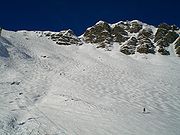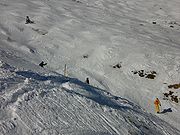
La Chavanette
Encyclopedia

Portes du Soleil
Les Portes du Soleil is a major skisports destination in the northern French alps encompassing thirteen resorts between Mont Blanc in France and Lake Geneva in Switzerland...
ski area, on the border between France
France
The French Republic , The French Republic , The French Republic , (commonly known as France , is a unitary semi-presidential republic in Western Europe with several overseas territories and islands located on other continents and in the Indian, Pacific, and Atlantic oceans. Metropolitan France...
and Switzerland
Switzerland
Switzerland name of one of the Swiss cantons. ; ; ; or ), in its full name the Swiss Confederation , is a federal republic consisting of 26 cantons, with Bern as the seat of the federal authorities. The country is situated in Western Europe,Or Central Europe depending on the definition....
. It can be reached from the French resort of Avoriaz
Avoriaz
Avoriaz is a French mountain resort in the heart of the Portes du Soleil. It is located in the territory of the commune of Morzine. It is easily accessible from either Thonon at Lake Geneva or Cluses-junction on the A40 motorway between Geneva and Chamonix...
and from the Swiss towns of Les Crosets
Les Crosets
rightAt , Les Crosets is the resort of highest altitude among those on the Swiss side of the Portes du Soleil. It is, however, one of the smallest as well. It is easily reached by skis from Chatel and Avoriaz. It has a microclimate and allows splendid views of the Dents Du Midi. The famous Swiss...
and Champéry
Champéry
Champéry is a municipality in the district of Monthey in the canton of Valais in Switzerland.-History:Champéry is first mentioned in 1286 as Champery...
. Effectively, one starts the run standing on the Swiss-French border, plunging down the Swiss side of the mountain towards Les Crosets.
Statistics
The slope is classified in the Swiss/French difficulty rating as orange, which means that it is rated as too difficult to fit in the standard classification of blue (easy), red (intermediate) and black (difficult). It has a length of 1 kilometer and a vertical drop of 331 meters, starting at 2,151 meters above sea level.Slope layout

After the initial 50 meters, the slope widens to the left, allowing skiers and boarders to traverse to a less steep area and make their descent by curving around the more steep and dangerous path directly down the slope.
The direct path goes into a pass between two rocky areas on the right hand side of the slope, about halfway down, which at its narrowest is about ten meters wide. This gives the skier or boarder an impression of being in a very steep half pipe with moguls.
After this passage, the slope eases out with fewer moguls, and narrows as the easier left-hand path merges with the direct path. The last two hundred yards are a flat run directly towards the chair lift back up the mountain, or the easier runs towards Les Crosets and Champéry.
How to ski/board it
The initial 50 yards have to be skied or boarded by everyone taking Le Pas de Chavanette. Especially without fresh snow, the slope gets icy quickly, turning the area between moguls into ice sheets. Not making a turn in these situations means that you miss the next mogul, and pick up too much speed to make the next one after that, starting off a tumble that ends a couple hundred yards down the slope, while hitting a few dozen icy bumps in the course.After this initial stretch, the choice can be made, up until the rocky passage in the direct path, to escape to the less steep left hand side of the slope, where a stumble is less dangerous. The direct path down Le Pas de Chavanette, to the right hand side and down the rocky passage, should only be taken by very experienced skiers and riders that know how to handle moguls, as it is effectively a continuation of the first 50 yards.
As the slope eases out, it is easier to negotiate the moguls and make a single run down to the end, although the inclination and bumps still call for significant dexterity and physical strength.
Wearing protective gear like a helmet and a back protector is highly recommended.

